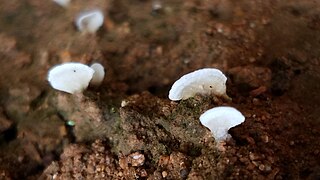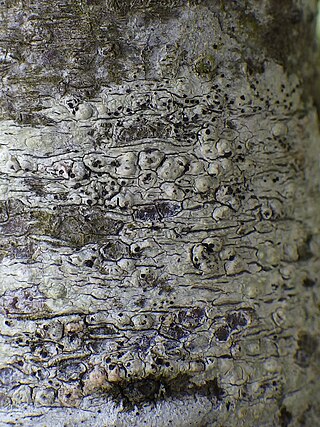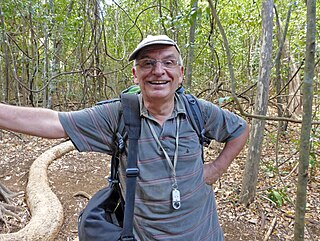Related Research Articles

Cyphellostereum is a genus of basidiolichens. Species produce white, somewhat cup-shaped fruit bodies on a thin film of green on soil which is the thallus. All Cyphellostereum species have nonamyloid spores and tissues, lack clamp connections, and also lack hymenial cystidia.

The Roccellaceae are a family of fungi in the order Arthoniomycetes. Most taxa are lichenized with green algae, although some are lichenicolous, growing on other lichens.
Acantholichen is a fungal genus in the family Hygrophoraceae. The genus was circumscribed by Norwegian lichenologist Per Magnus Jørgensen to contain the type, and at that time, only species, the basidiolichen Acantholichen pannarioides, discovered originally in Costa Rica in 1998. This species has a bluish, gelatinous thallus, and a fine, white powdery bloom covering the hairy upper surface; this surface is said to resemble "an unshaven chin". Five additional species, all basidiolichens, were added to the genus in 2016 following an in-depth analysis of specimens collected from the Galápagos, Costa Rica, Brazil and Colombia.
Neoechinodiscus is a genus of two species of lichenicolous fungi with uncertain familial placement in the order Helotiales.

Skyttea is a genus of lichenicolous (lichen-dwelling) fungi in the family Cordieritidaceae. The genus was circumscribed in 1981 by lichenologists Martha Allen Sherwood, David L. Hawksworth, and Brian J. Coppins, with Skyttea nitschkei assigned as the type species.
Subhysteropycnis is a fungal genus in the family Arthoniaceae. This is a monotypic genus, containing the lichenicolous fungus species Subhysteropycnis maculiformans, which is parasitic on Pseudocyphellaria glabra and Pseudocyphellaria homoeophylla.
Dictyonema is a genus of mainly tropical basidiolichens in the family Hygrophoraceae.
André Aptroot is a Dutch mycologist and lichenologist.
Cora hirsuta is a species of basidiolichen in the family Hygrophoraceae. Found in the páramo region near Bogotá at over 3,000 m (9,800 ft) elevation, it was described as new to science in 2011. The lichen, characterised by its distinctively hairy upper surface and smaller lobes, thrives in a variety of habitats, including soil, bryophytes, and as epiphytes on trees.

Cora is a large genus of basidiolichens in the family Hygrophoraceae. Modern molecular phylogenetics research has revealed a rich biodiversity in this largely tropical genus.
Thomas Hawkes Nash III is an American lichenologist. His research is about the biology and ecology of lichens, and the effects of air pollution on plants and lichens. He is known as an authority on the family Parmeliaceae. During his long career at the Arizona State University, he helped develop the lichen herbarium into a world-class collection with over 100,000 specimens representing more than 5000 species. In 2010, the year of his retirement, he was awarded the Acharius Medal for lifetime achievements in lichenology, and the following year had a Festschrift published in his honor.
Briancoppinsia is a fungal genus in the family Arthoniaceae. It is monotypic, containing the single species Briancoppinsia cytospora, a lichenicolous fungus that parasitises parmelioid lichens, as well as Cladonia, Lepra, and Lecanora conizaeoides, among others. The species was first described scientifically by Léon Vouaux in 1914 as Phyllosticta cytospora. The genus was circumscribed in 2012 by Paul Diederich, Damien Ertz, James Lawrey, and Pieter van den Boom. The genus was named for Brian John Coppins, who is, according to the authors, an "eminent British lichenologist and expert of lichenicolous fungi".

Emmanuël Sérusiaux is a Belgian lichenologist. His career, spanning more than four decades, has combined both lichenology research and political aspects of nature conservation. He spent several periods working as a researcher at the National Fund for Scientific Research and the University of Liège, the latter in which he accepted a faculty position as professor and head of the Plant Taxonomy and Conservation Biology unit. Sérusiaux also served for three non-consecutive appointments as Deputy Chief of Staff in the Government of Wallonia. He retired from both his academic and political positions in 2019.

Sclerococcum is a genus of lichenicolous fungi in the family Dactylosporaceae.
Xenonectriella subimperspicua is a species of lichenicolous fungus in the family Nectriaceae. It has been recorded from South America, Europe, and New Zealand.
Cora lawreyana is a species of basidiolichen in the family Hygrophoraceae. Found in Mexico, it was formally described as a new species in 2019 by Bibiana Moncada, Rosa Emilia Pérez-Pérez, and Robert Lücking. The type specimen was collected in the La Cortadura Ecological Reserve in a cloud forest at an altitude of 2,088 m (6,850 ft). It is only known to occur at the type locality, where it grows as an epiphyte on the trunks of trees, usually on or around mosses and liverworts, such as from the genera Frullania, Metzgeria, and Plagiochila. The specific epithet honours lichenologist James D. Lawrey, who, according to the authors, "has made numerous contributions to lichenology in such diverse fields as ecology, lichenicolous fungi, and the evolution of basidiolichens and their photobionts".
Henricus (Harrie) Johannes Maria Sipman is a Dutch lichenologist. He specialises in tropical and subtropical lichens, and has authored or co-authored more than 250 scientific publications. He was the curator of the lichen herbarium at the Berlin Botanical Garden and Botanical Museum from 1983 until his retirement in 2010.

Robert Lücking is a German lichenologist. He earned his master's and PhD from the University of Ulm, focusing on the taxonomy, ecology, and biodiversity of foliicolous lichens. He has received numerous awards for his work, including the Mason E. Hale award for his doctoral thesis, the Augustin Pyramus de Candolle prize for his monograph, and the Tuckerman Award twice for his publications in The Bryologist. Since 2015, he has been serving as the curator of lichens, fungi, and bryophytes at the Berlin Botanical Garden and Botanical Museum, and several lichen species and a genus have been named in his honour.
Parmotrema lawreyi is a species of corticolous (bark-dwelling), foliose lichen in the family Parmeliaceae. Found on the Galápagos Islands, it was formally described as a new species in 2019 by lichenologists Frank Bungartz and Adriano Spielmann. The type specimen was collected by the first author from the foothills of Media Luna on San Cristóbal Island, where it was found in dry, open woodland growing on the trunk of Bursera graveolens. The species epithet honours the authors' colleague James D. Lawrey, "on the occasion of his 70th birthday".
References
- 1 2 3 4 Lücking, Robert; Dal Forno, Manuela; Will-Wolf, Susan (2019). "James Donald ('Jim') Lawrey: a tribute to a unique career in lichenology". Plant and Fungal Systematics. 64 (2): 117–135. doi: 10.2478/pfs-2019-0014 . Retrieved 2 September 2022.
- 1 2 Diederich, Paul; Lücking, Robert; Ertz, Damien; Miadlikowska, Jolanta; Flakus, Adam (2019). "A tribute to James D. Lawrey, honoring a unique career in the biology of lichens and lichenicolous fungi". Plant and Fungal Systematics. 64 (2): 115. doi: 10.2478/pfs-2019-0013 .
- 1 2 3 4 "Acharius Medallists James D. Lawr". International Association for Lichenology. Retrieved 2 September 2022.
- ↑ "James Lawrey". George Mason University. Retrieved 31 August 2022.
- ↑ "Lawrey Lab". George Mason University. Retrieved 31 August 2022.
- ↑ Lücking, R; Moncada, B (2017). "Dismantling Marchandiomphalina into Agonimia (Verrucariaceae) and Lawreymyces gen. nov. (Corticiaceae): setting a precedent to the formal recognition of thousands of voucherless fungi based on type sequences". Fungal Diversity. 84: 119–138. doi:10.1007/s13225-017-0382-4. S2CID 256066054.
- ↑ Bungartz, Frank; Spielmann, Adriano A. (2019). "The genus Parmotrema (Parmeliaceae, Lecanoromycetes) in the Galapagos Islands". Plant and Fungal Systematics. 64 (2): 173–231. doi: 10.2478/pfs-2019-0018 . S2CID 210075798.

- ↑ International Plant Names Index. Lawrey.